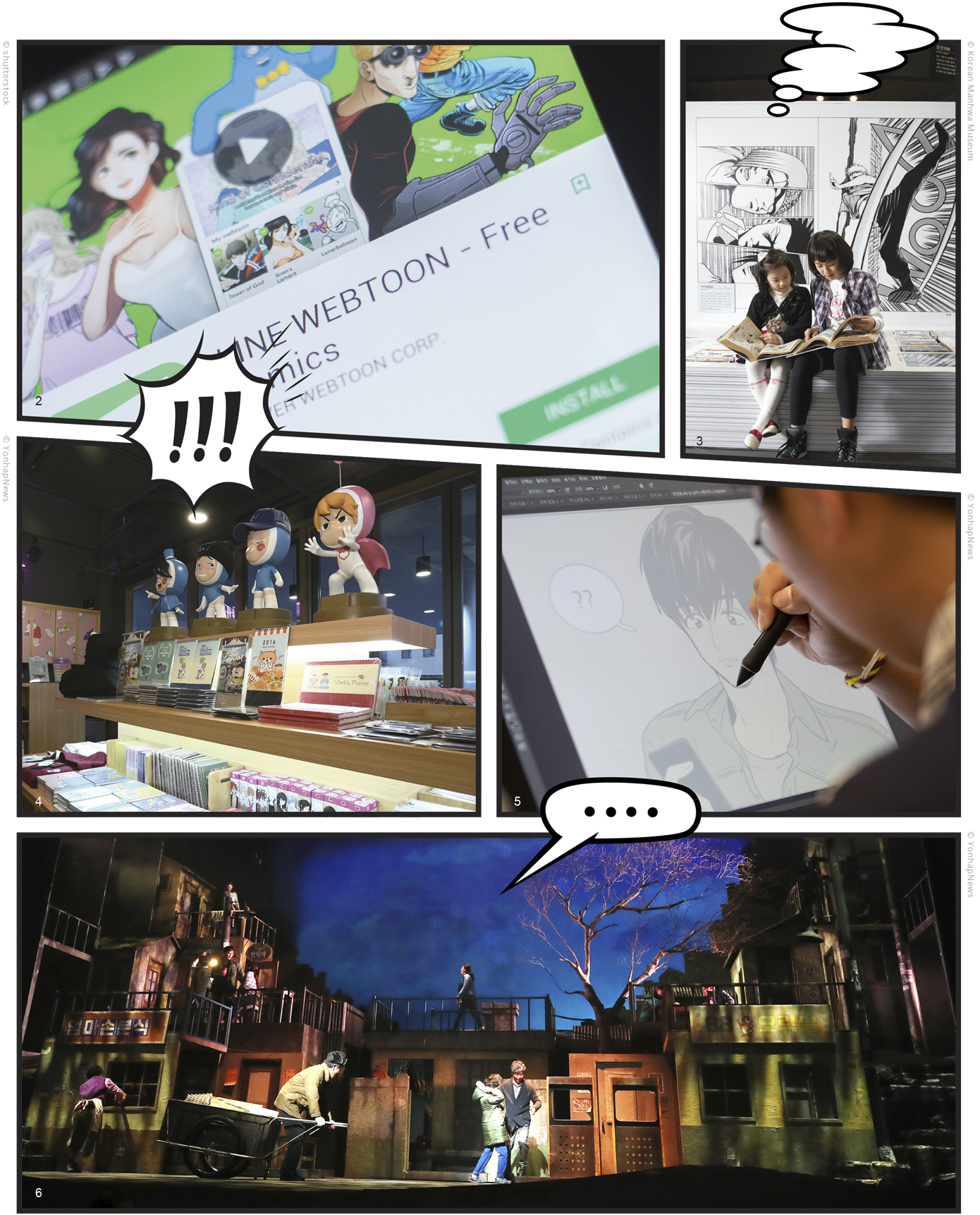STORY
How Webtoons Swept Korea
Content for Digital Age
The webtoon, a digital comic invented in Korea, has shaken up the comic book market thanks to the advent of smartphones. From plots ranging from fantasy and science fiction to everyday life in Korea, the medium is growing by leaps and bounds in popularity and sales both in Korea and abroad, and could become another engine propelling the growth of Hallyu throughout the world.
Written by• Kim Bong Seok,
former editor-in-chief of A-Comics
The widespread use of smartphones has made webtoons (online comics) a widely accessible medium for all ages. The emergence of webtoons indicates a rapid shift in cultural consumption patterns as shown in rising demand for instant, bite-size content.
Early Development
In webtoon’s early stage, much of its content revolved around familiar narratives that documented ordinary episodes or issues in daily life. Many uploaded their personal reflections or stories on company websites, forums or similar communities. The rise of this medium coincided with a crisis in the Korean cartoon industry in the 1990s, when publications were shut down partly due to stronger censorship laws to protect teens and sales plummeted due to comic rental services. Late in the same decade, however, new formats and styles of cartoon content like “Snow Cat” and “Marine Blues” rose in popularity.
Unprecedented Boom
In the 2000s, web portals began to operate platforms for browsing and consuming webtoon serials. The trend started with Yahoo and was quickly picked up by Korean search engine portals like Naver and Daum. Featuring webtoon content became part of the portals’ business or user acquisition strategy as a means to increase traffic. By this point, cartoon publishers saw little point in heeding or being intimidated by digitalization. Though the internet featured novice artists whose works were deemed inferior, the disruption that awaited the industry was largely unexpected. The turning point came in 2003, when Kang Full’s webtoon “Love Story” (or its film adaptation “Hello, Schoolgirl”) saw tremendous success. The print cartoon sector also faced an unprecedented contraction that forced leading publishers to start pivoting toward webtoons.

Two fans take a selfie with their favorite webtoon character. © YonhapNews
Double-edged Receptivity
The search engines stayed faithful to user needs by prioritizing and giving exposure to content based on popularity. This feedback-oriented approach leveraged the power of the web, especially its power of mutual interaction. Gauging an artistic medium, however, should never excessively rely on empirical data like traffic and number of comments, as these cannot sufficiently determine quality of a work. In extreme cases, cartoons with subpar artistic quality but surefire appeal factors like trendy humor thrived. At other times, plots or other core traits of an ongoing series fluctuated in response to reader requests or reactions.
Webtoon genres commanding wide audiences consist of the topics or themes of humor, fantasy and daily life. Meanwhile, works considered artistically exceptional but not exactly mainstream are rarely given exposure by a platform or promoted by algorithms. Another side effect is the plummeting sales of print comics.
Expansion & Evolution
Nonetheless, adaptations of original webtoons in other media like graphic novels often sold well upon publication. In short, the expanded market for the medium allowed greater room for more diverse works. New consumer or reader needs popped up, as did the quantity and ever-widening scope of webtoon content.
As the webtoon market expanded, more platforms for serials emerged, whether portals or comic-specialized websites. Episodic narratives dominated the early age of webtoons, but stories later began to feature more dramatic plots. Another evolution was how webtoons were visually styled to fit the vertical scrolling sequence of display on a smartphone screen.
Webtoons fared well in audience reception for a variety of reasons. Korean comics or manhwa transitioned abruptly from print to digital, and online cartoons grew popular thanks to being free in the initial stage. The web portals paved a new channel through which webtoon artist or writers could debut. Even those lacking artistic finesse could achieve stardom as long as they captured reader empathy and interest.
The libertarian system of evaluating and incorporating reader responses enabled webtoons to take off like no other system before. Graphic novels in Korea failed to grab a presence as they did in the Western Hemisphere or the U.S., and in their place came webtoons as the primary source of comic creativity.

2. Line Webtoon is the world’s leading platform for digital comics. / 3. Manhwa (comic books) content appeals to children. / 4. Comics or cartoon-based figures and merchandise for sale are on display. / 5. Sketchpads are being more frequently utilized by both professionals or amateurs. / 6. “Along with the Gods: The Two Worlds” is a benchmark for adaption of a webtoon into other media. Shown here is a musical based on the hit webtoon at LG Arts Center in Seoul in June 2019.
Classic & Newfound Appeal
2013 was a watershed year for webtoon’s entry into the Korean mainstream. “Misaeng (An Incomplete Life)” sold more than 500,000 print copies of its first season after its webtoon premiere, while “Secretly, Greatly” in 2014 set a standard for a webtoon’s popularity and appeal.
White-collar workers in Korea could relate to poignant moments and narrative arcs in “Misaeng.” “Secretly, Greatly,” on the other hand, especially appealed to teenagers and women in their 20s and 30s, apart from featuring heartthrob actor Kim Soo-hyun.
A outpouring of film and dramas based on webtoons occurred after the medium boomed such as “Moss” (2010), “26 Years” (2012), “The Neighbors” (2013), “Fists of Legend” (2013), “Inside Men” (2015), “Start-Up” (2019), “Cheese in the Trap” (2016), “Mystic Pop-up Bar” (2020), “Itaewon Class” (2020), “What’s Wrong with Secretary Kim?” (2018) and “Hell is Other People” (2019). “Along with the Gods” is perhaps one of the most successful webtoons to be adapted by other media, as it was made not only into a musical but two blockbuster movies.
The Korean webtoon market skyrocketed from USD 360 million in 2015 to over USD 770 million last year. These stats are hardly surprising considering the masses of commuters who habitually consume webtoons as part of their daily routines. An estimated eight million readers read such content, with over 100 serials updated daily. Today, webtoons command wide readership and exert hefty impact in Korea as a primary source of leisure content.



















